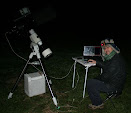Ando trabajando con Peranso para conocer sus limitaciones y tiene una que convendría trabajar. Cuando en una misma noche hay varios observadores que han medido cosas parecidas pero no exactamente las mismas.
Lo ideal sería compaginarlas tres series una sola. Peranso permite desplazar las curvas sustrayendo su valor medio.Pero claro está, el valor medio de cada curva depende de las observaciones de cada curva.
Así la corrección que hace Peranso deja la composición siguiente:
No es capaz de agrupar correctamente las observaciones de los tres observadores de esa noche. Por consiguiente el análisis de periodo falla al encontrar una curva que pegaría "saltos"entre las tres curvas.
Una solución sería encontrar un modo de equilibrar la altura de las curvas de forma automática, otra solución sería calcular las pendientes de cada curva y usar estas nuevas curvas que ya no tienen diferencia entre ellas.
Las curvas de las pendientes para los tres observadores de la gráfica sale de la siguiente manera.
Al comparar las pendientes, si todos han visto algo parecido, las curvas deben de superponerse más o menos bien.
Y usando estos datos podemos hacer un estudio de periodicidad de las curvas como lo hacemos con las magnitudes.






5 comentarios:
1) slopes of the light curves: https://ui.adsabs.harvard.edu/abs/2017OAP....30...93K/abstract
https://ui.adsabs.harvard.edu/abs/2017CKA....14..283K/abstract
2) slopes as delta_m/delta_t have larger relative scatter than the magnitudes - typically by a factor of 1.4. Anyway, these points have systematic difference at the end
3) the mean values, as in Peranso, I hate. It may have some sense for the same time/phase intervals. E.g. temperature in January in Sevilla and in Odessa, but not in winter in Sevilla and mean annual in Odessa. So the advice is to remove data outside the overlapping interval, to determine the difference of the mean values for these overlapping data, and then to add this to the rest of the data.
4) In our software MCV, http://uavso.org.ua/mcv/MCV.zip , there is a possibility of making quasi-simultaneous "observations". Typically, we use this to our typical VRVRVR two-color observations - this is based on a local cubic parabola approximation usin 2 points before and two points after the point in another color. The minimum interval is determined not to use distant pairs. So this will not work for independent series, where the times of observations may coinside. This may be added to the program, if needed (I mean the user-defined interval instead of the automatic one). And then to determine mean "color index". Anyway, the observations by different observers have different "colors"=instrumental systems.
5) for a good phase coverage, one may make a trigonometric polynomial fit of a statistically optimal order, and may use the mean (= mean over the continuous curve during a period, rather than a sample mean at inhomogeneously spaced phases.
6) For the statistically optimal determination of the moments of extrema, we have another software http://uavso.org.ua/mavka
7) Both MCV and MAVKA are free, AS IS, but the references in Your papers are expected.
Clear skies!
Como ya te comenté, es el gran punto débil de Peranso. Todo lo demás es maravilloso. Y por eso cada día alucino más con la maravilla que hizo Julio Castellano con FotoDif, todo con un clic. Me temo que Peranso está más pensado para muchas medidas de un único observador. O para variables periódicas donde a través de diversos máximos o mínimos es relativamente fácil encontrar el punto zero para cuadrar todas las medidas. Por eso es labor casi imposible usarlo en rotaciones de asteroides, yo cada vez que lo he intentado he tenido que desistir. Quizá convendría comentárselo a Tonny para que intente mejorar este aspecto.
Veo que he comentado como anónimo jeje. Soy Juan-Luis ;-)
Very thanks Mr Andronov
La verdad, que es el punto débil de Peranso, a ver si recupero el programa que escribí hace ya 30 años para compaginar series temporales a una única serie con las series individuales desplazadas en el eje y por su desviación media con respecto a la curva media.
Publicar un comentario